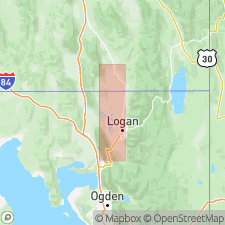
- Usage in publication:
-
- Cache Valley group
- Modifications:
-
- Original reference
- AAPG geologic province:
-
- Wasatch uplift
Summary:
Pg. 603-606, 634, 635, 640, 641. Cache Valley group. Soft marls and sands, best exposed in north side of Cache Valley [northeastern Utah and southeastern Idaho] and on Bear River below the middle canyon. They are somewhat variegated and horizontal in position. Deposited in lake, which shows a number of levels. Possibly of same age as Malade Valley group and possibly older. Age is Pliocene(?). [Now [ca. 1938] considered probably of same age as Salt Lake formation.]
Source: US geologic names lexicon (USGS Bull. 896, p. 311).

- Usage in publication:
-
- Cache Valley formation
- Modifications:
-
- Revised
- AAPG geologic province:
-
- Wasatch uplift
Summary:
Pg. 73, 75 (fig. 2). Formation at top of Salt Lake group. Overlies West Spring formation (new). Thickness 1,000 to 2,000 feet. [Age is middle and late Pliocene.]
Source: US geologic names lexicon (USGS Bull. 1200, p. 570).

- Usage in publication:
-
- Cache Valley formation
- Modifications:
-
- Redefined
- AAPG geologic province:
-
- Wasatch uplift
Summary:
Pg. 1, 2, 6-7. Redefined to /include West Spring formation. Thickness 7,674 feet. Overlies Collinston conglomerate; underlies Mink Creek conglomerate (new). [Age is] Miocene and Pliocene.
[Assigning a formation to a formation is in conflict with rank hierarchy of formal lithostratigraphic units (see CSN, 1933). Perhaps the strata included in West Spring formation by previous workers, are reallocated to Cache Valley formation in this report?]
Source: US geologic names lexicon (USGS Bull. 1200, p. 570).
For more information, please contact Nancy Stamm, Geologic Names Committee Secretary.
Asterisk (*) indicates published by U.S. Geological Survey authors.
"No current usage" (†) implies that a name has been abandoned or has fallen into disuse. Former usage and, if known, replacement name given in parentheses ( ).
Slash (/) indicates name conflicts with nomenclatural guidelines (CSN, 1933; ACSN, 1961, 1970; NACSN, 1983, 2005, 2021). May be explained within brackets ([ ]).

